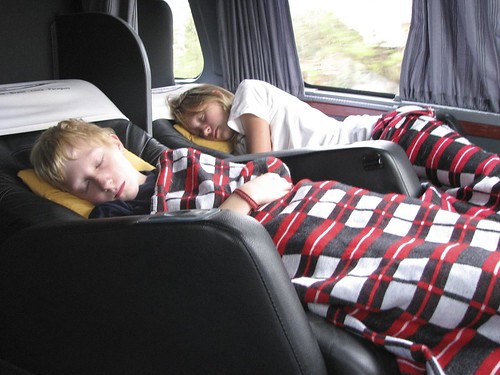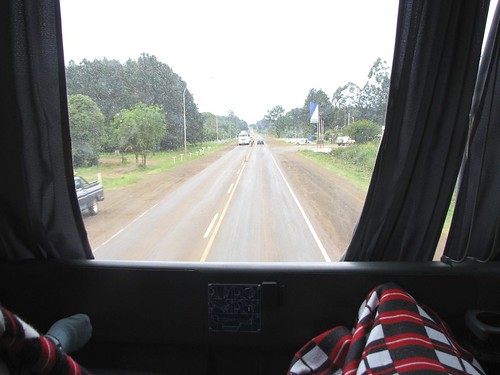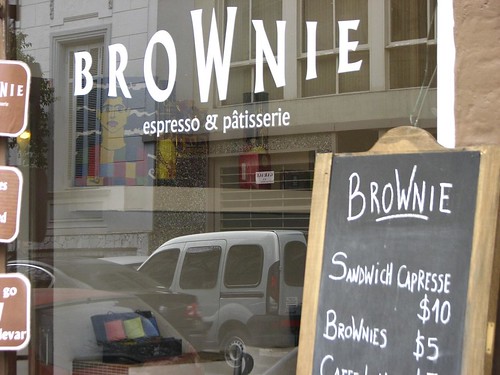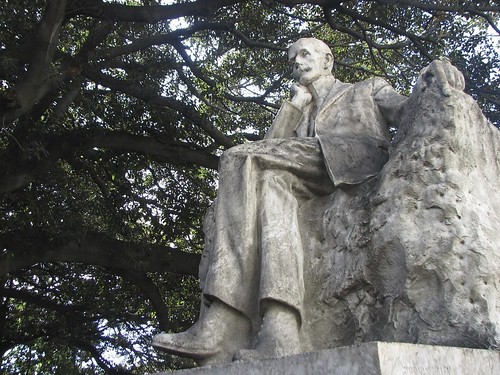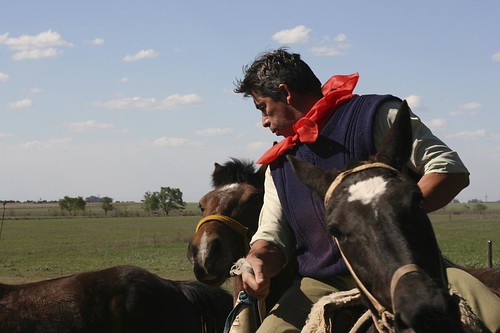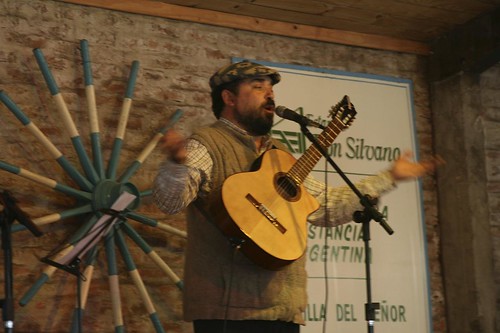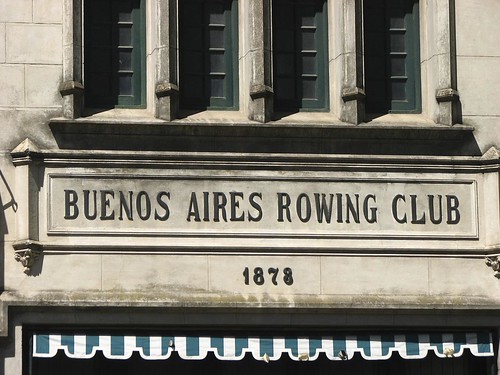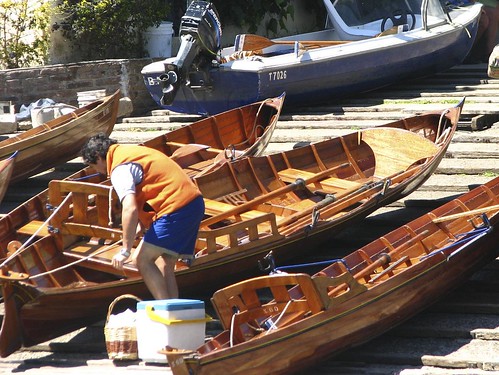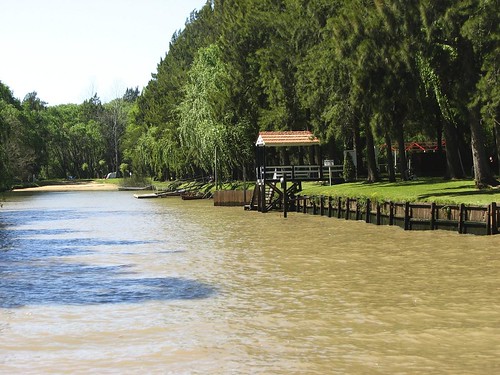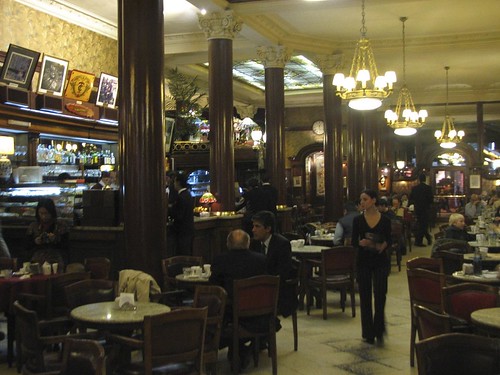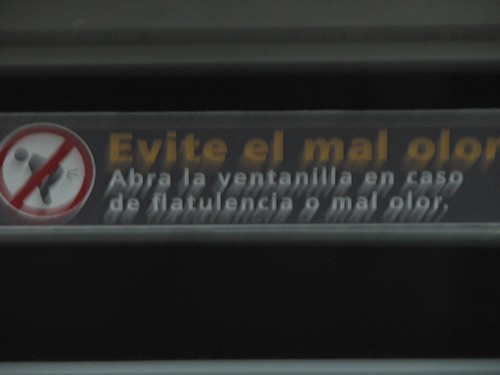Category — Argentina
Full Cama
Most Americans would rather have a root canal than endure a 17-hour bus ride. Almost any form of transportation is preferable to riding the dog.
Not so in Argentina.
More than one person had told me that Argentine long-distance buses were comfortable and affordable. But we were all surprised by how enjoyable it is to travel on them.
Truth be told, by the time we had reached Puerto Iguazu after the overnight journey from Buenos Aires, none of us wanted to leave the Crucero del Norte bus. Because we were traveling full cama.
We boarded our bus at 7:30 pm at Retiro station and were due to arrive in Puerto Iguazu at 12:30 pm the next afternoon. Our seats resembled overstuffed recliners and were ingeniously designed to fold out into comfortable beds.
Each “cama suite” had its own flat screen TV, and they didn’t play the overheated action films so prevalent on long-distance buses. We got a Meg Ryan movie first followed by the always excellent Tommy Lee Jones in In the Valley of Elah.
From the moment we boarded the “service” began. Within the space of ninety minutes we were offered complimentary whiskey, wine and champagne – all this before dinner.
Around 11 pm they dimmed the bus’s interior lights and, almost in unison, our 24 fellow passengers converted their seats into beds. Dani, the kids and I slept pretty soundly until breakfast was served the next morning at 6:30 am.
When pulled into the Omnibus Terminal right on schedule, Caroline and Conor were actually disappointed to leave the bus.
So I shared with them this good news: We have at least two more long-distance bus rides in our near future.
But here’s the bad news: The only service available on our 23-hour trip from Iguazu to Salta is semi-cama.
Something tells me that after you’ve traveled full cama, semi-cama ain’t gonna cut it.
October 20, 2008 6 Comments
Hasta La Vista, BsAs
It’s hit me. Our time in Buenos Aires is drawing to a close and now we must say goodbye to the life we’ve built here over the last five weeks.
In a short time we have made little routines and found favorite spots.
This is my kind of adventure: Yellow bananas on the counter, a pot of coffee brewing, clothes unpacked and folded in drawers.
Outside, after we’ve slept in good and late, there are museums to discover, restaurants to sample, markets to stroll through. Seems I am most satisfied having adventures from a home base.
As my friend Kate put it, “It’s enough stimulation and challenge to try to make a nest in an unfamiliar tree.”
When we leave our Buenos Aires nest we will miss the sweet couple who owns the lavandaria two doors down, the vegetable and fruit man who offers samples of mandarinas with a twinkle in his eye, the pleasant amble to the Scalabrini Ortiz Subte stop, the lady at the fresh pasta shop who is charmed by the kids’ Spanish, a bedtime snack of sliced apples dipped in dulce de leche, sweet medialunas from the bakery across the street.
Amazing sights await us. And I know we will find other places to love. But I don’t think we’ll be in another single place long enough to feel this sense of belonging.
BsAs has thrilled us with its green spaces and flowering trees, elegant architecture, walkable neighborhoods, and excellent food.
What great place to spread out the school books, cook dinner and relish the beauty of routine.
October 17, 2008 5 Comments
Xul Solar and Mr. Puffy Pants
If you haven’t visited Caroline and Conor’s blog recently, you should check out their latest posts on the odd Argentine artist Xul Solar and the day spent partying with Mr. Puffy Pants.
October 15, 2008 2 Comments
Long Walk Home
This past week we booked an estancia tour to ride horses, have asado and see a gaucho show. The tour company called it a Fiesta Gaucho. Sounds like a fun day, eh?
Yet when it was over, I felt a sadness that was difficult for me to shake. Here’s what happened.
We boarded a full tour bus and drove 50 miles north of Buenos Aires to Don Silvano’s Estancia. When we arrived we went for trail ride, played bocce and walked around the grounds.
Shortly after 1 pm lunch was served, a typical Argentine asado with about five different types of grilled meat.
Then the music started. Several entertainers took the stage and began singing Argentine folk songs and performing traditional dances.
As the program began to wind down, the emcee noted that there were visitors from thirteen nations, and he began calling people to the stage to sing a folk song that represented their country.
“South Africa! Where is our guest from South Africa?”
The burly man who had been sitting next to me on the bus took the stage, and after some minor arm-twisting, he sang a song in a language I did not recognize.
The audience got into the spirit, and began calling for countries to take the stage. Columbia. Venezuela. Peru. Japan. Each performance and country were warmly applauded.
Surely they’d be calling for the United States soon. What if we were the only Americans? What would we sing?
After several more performances, including a group of twenty Australian senior citizens warbling their way through “Waltzing Matilda,” it dawned on me: There would be no calls to hear from the United States.
It’s not that we weren’t welcome; we surely were. But there was no rush to celebrate us either.
At that moment I felt the full force of the last eight years.
And it became very clear to me that, in the eyes of the world, we had squandered the idea, the spirit, the goodness of America.
Later that afternoon, as the party moved outside for the gaucho show, we found ourselves sitting next to a woman from Malaysia. She began telling us about her travels, then about her country.
When we told her we might visit Malaysia as part of our trip, she said very straightforwardly, “You in the West are very privileged. In Malaysia, we could never take that much time off. There is always work, school. Things we must do.”
On the bus ride back to Buenos Aires, I couldn’t shake my melancholy. I thought about what the Malaysian woman had said. We are privileged. Privileged to live in a country that for most of its history has been a symbol of hope and opportunity.
Soon America will turn the page. I hope we return to our better selves. But it’s going to be a long walk home.
October 13, 2008 9 Comments
San Telmo Sundays
The San Telmo Sunday market has been one of our favorite outings during our month-long stay in Buenos Aries. Take a look and you’ll see why.
And if you haven’t had a chance to see our earlier videos, be sure to check them out too. It’s a great way to procrastinate.
October 9, 2008 2 Comments
ADIP: Tigre, Argentina
A Day in Pictures
Tigre, Argentina
City dwellers the world over have places where they escape, destinations that provide relief from the hectic pace of urban life. For portenos, Tigre is that kind of place.
Located twenty kilometers north of Buenos Aires at the edge of the Parana Delta, Tigre was once the destination of choice for the city’s elite.
Today Tigre is a preferred day trip, easily accessible by train. People come to relax and enjoy the lush green islands and maze of waterways that define the delta region.
October 7, 2008 6 Comments
Buenos Aires Time
The first clue that we would have to make some adjustments to our body clocks came in our landlord’s verbal checklist: Open the window like this, turn on the oven like that, and “Best to put out the trash in the afternoon,” he said, “between 6 and 8 p.m.”
Maybe it was just a shaky translation. Could 8 p.m. be considered anything but the dead of night?
At home we are, like all industrious Americans, “early to bed, early to rise.” But here we have been slipping almost unaware into Buenos Aires time.
It is not an issue of jet lag. The day here simply begins and ends later.
Flipping through my guidebook, I can find only one museum that opens before 2 p.m. Restaurants open for dinner at 9 p.m. and diners begin to trickle in at 10 p.m. or so.
From our bedroom window, you can watch people – lots of them – leisurely walking their dogs between 3 and 4 in the morning.
The tango show we saw last week began at 11 p.m. Everyone around seemed to think this was completely normal.
It’s no wonder, I suppose, that we are still in pajamas at 10:30 in the morning and that we look at our watches during an outing to find that it’s not 2 p.m., but 5 p.m.
When October arrives, we expect our days to grow shorter, but here in South America, the tenth month brings the long, leafy days of spring.
Our signals have gone awry.
We are upside down, posing for a picture next to a blooming azalea bush – and sitting down for dinner at bedtime.
October 3, 2008 5 Comments
Surreal Zoo
Caroline said what I had been thinking: “I hope this isn’t one of those illegal zoos.”
We had traveled 40 miles outside of Buenos Aires to the Lujan Zoo on the promise that we would be able to interact closely with the animals. That turned out to be an understatement.
According to Mariana, our guide for the day, the zoo had been operating for fifteen years, and was unique in South America. I’d certainly never visited another zoo like it.
We were four of only seven visitors to the zoo on a cool and overcast Monday. Minutes after we arrived we were escorted to the area where the elephants were kept – not a cage, mind you, more like a large pen.
Caroline and Conor were riding an elephant around a yard before I could say Dumbo.
As it turned out, riding an elephant was least of what we did that day.
October 1, 2008 4 Comments
It Takes Two
I expected – even hoped – there would be many “teachable moments” on our trip. But I never imagined one would occur at a tango show in Buenos Aires. Given the history of the tango, I should have known better.
The Argentine writer Jorge Luis Borges, a tango enthusiast and amateur music historian, wrote: “My informants all agree on one fact – the tango was born in the brothels.”
Borges was one to never let the truth get in the way of a good story. While no one can pinpoint the tango’s exact birthplace, it did develop among the portenos (the people of the port area of Buenos Aires) in bordellos and bars.
Like rap or hip-hop today, it was urban music, forged from a range of musical influences, and carrying a subversive undertone.
In its early form, the tango romanticized the life of bohemian knife-wielding womanizing thugs. Dances had a threatening, predatory quality – and often depicted a possessive relationship between two men and a woman.
Of course, I knew none of this when I signed up to take my kids to a tango show.
September 29, 2008 2 Comments
Observed in Buenos Aires II
Friends know my humor runs to the scatological. As you can imagine, I fell off my chair laughing at this sign on the Buenos Aires subway.
Roughly translated: Keep the window open to avoid bad odors.
And notice the international symbol for “no flatulence” on the left hand side of the sign.
September 28, 2008 Comments Off on Observed in Buenos Aires II


